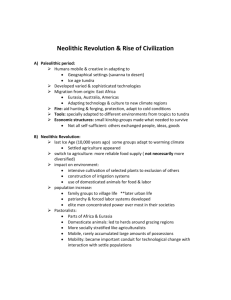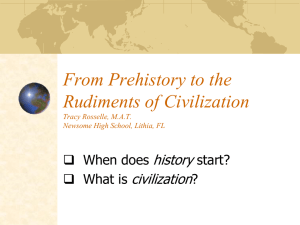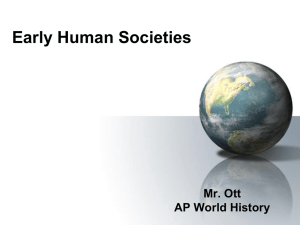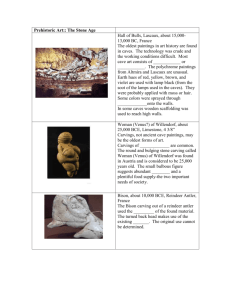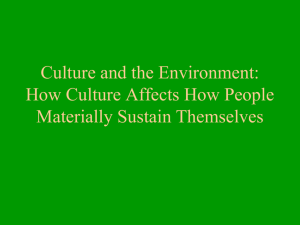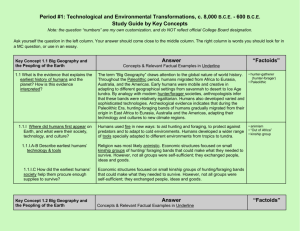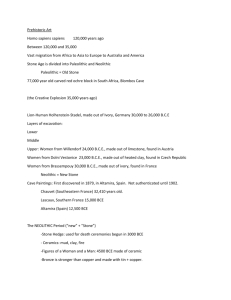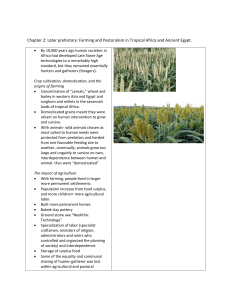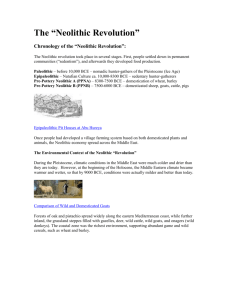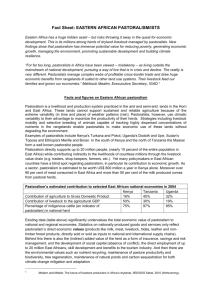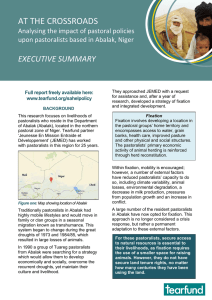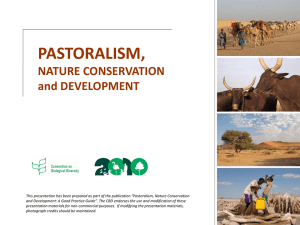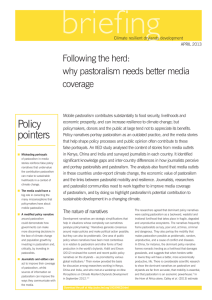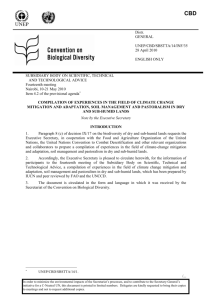The Neolithic Revolution & Early Agricultural Societies Lecture
advertisement
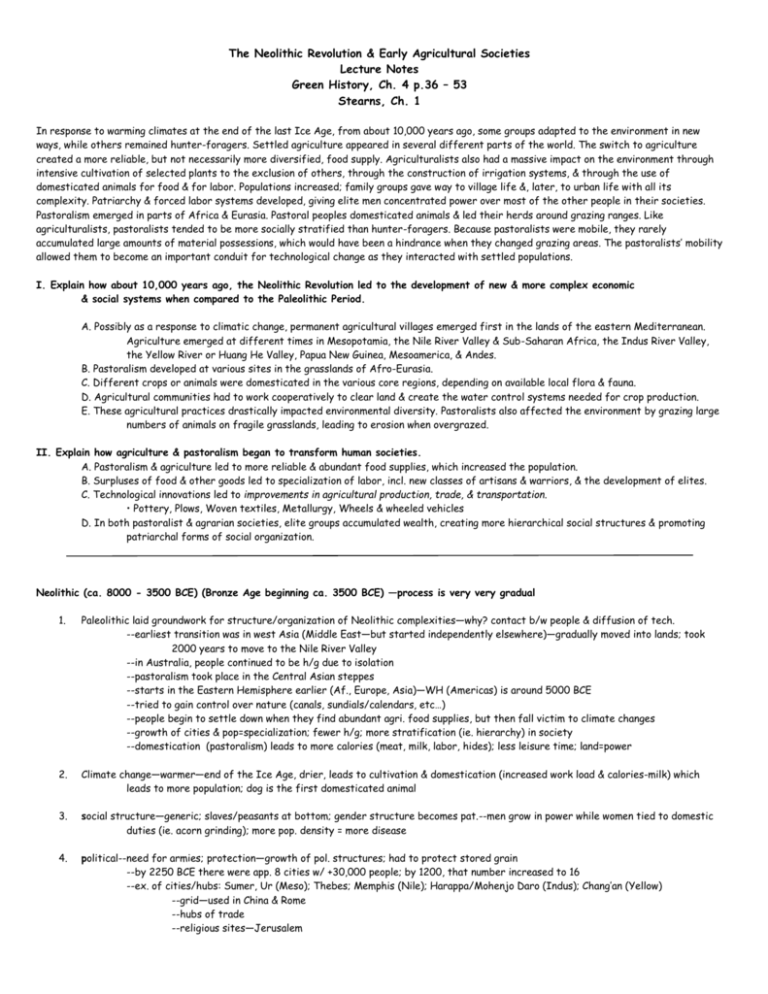
The Neolithic Revolution & Early Agricultural Societies Lecture Notes Green History, Ch. 4 p.36 – 53 Stearns, Ch. 1 In response to warming climates at the end of the last Ice Age, from about 10,000 years ago, some groups adapted to the environment in new ways, while others remained hunter-foragers. Settled agriculture appeared in several different parts of the world. The switch to agriculture created a more reliable, but not necessarily more diversified, food supply. Agriculturalists also had a massive impact on the environment through intensive cultivation of selected plants to the exclusion of others, through the construction of irrigation systems, & through the use of domesticated animals for food & for labor. Populations increased; family groups gave way to village life &, later, to urban life with all its complexity. Patriarchy & forced labor systems developed, giving elite men concentrated power over most of the other people in their societies. Pastoralism emerged in parts of Africa & Eurasia. Pastoral peoples domesticated animals & led their herds around grazing ranges. Like agriculturalists, pastoralists tended to be more socially stratified than hunter-foragers. Because pastoralists were mobile, they rarely accumulated large amounts of material possessions, which would have been a hindrance when they changed grazing areas. The pastoralists’ mobility allowed them to become an important conduit for technological change as they interacted with settled populations. I. Explain how about 10,000 years ago, the Neolithic Revolution led to the development of new & more complex economic & social systems when compared to the Paleolithic Period. A. Possibly as a response to climatic change, permanent agricultural villages emerged first in the lands of the eastern Mediterranean. Agriculture emerged at different times in Mesopotamia, the Nile River Valley & Sub-Saharan Africa, the Indus River Valley, the Yellow River or Huang He Valley, Papua New Guinea, Mesoamerica, & Andes. B. Pastoralism developed at various sites in the grasslands of Afro-Eurasia. C. Different crops or animals were domesticated in the various core regions, depending on available local flora & fauna. D. Agricultural communities had to work cooperatively to clear land & create the water control systems needed for crop production. E. These agricultural practices drastically impacted environmental diversity. Pastoralists also affected the environment by grazing large numbers of animals on fragile grasslands, leading to erosion when overgrazed. II. Explain how agriculture & pastoralism began to transform human societies. A. Pastoralism & agriculture led to more reliable & abundant food supplies, which increased the population. B. Surpluses of food & other goods led to specialization of labor, incl. new classes of artisans & warriors, & the development of elites. C. Technological innovations led to improvements in agricultural production, trade, & transportation. • Pottery, Plows, Woven textiles, Metallurgy, Wheels & wheeled vehicles D. In both pastoralist & agrarian societies, elite groups accumulated wealth, creating more hierarchical social structures & promoting patriarchal forms of social organization. Neolithic (ca. 8000 - 3500 BCE) (Bronze Age beginning ca. 3500 BCE) —process is very very gradual 1. Paleolithic laid groundwork for structure/organization of Neolithic complexities—why? contact b/w people & diffusion of tech. --earliest transition was in west Asia (Middle East—but started independently elsewhere)—gradually moved into lands; took 2000 years to move to the Nile River Valley --in Australia, people continued to be h/g due to isolation --pastoralism took place in the Central Asian steppes --starts in the Eastern Hemisphere earlier (Af., Europe, Asia)—WH (Americas) is around 5000 BCE --tried to gain control over nature (canals, sundials/calendars, etc…) --people begin to settle down when they find abundant agri. food supplies, but then fall victim to climate changes --growth of cities & pop=specialization; fewer h/g; more stratification (ie. hierarchy) in society --domestication (pastoralism) leads to more calories (meat, milk, labor, hides); less leisure time; land=power 2. Climate change—warmer—end of the Ice Age, drier, leads to cultivation & domestication (increased work load & calories-milk) which leads to more population; dog is the first domesticated animal 3. social structure—generic; slaves/peasants at bottom; gender structure becomes pat.--men grow in power while women tied to domestic duties (ie. acorn grinding); more pop. density = more disease 4. political--need for armies; protection—growth of pol. structures; had to protect stored grain --by 2250 BCE there were app. 8 cities w/ +30,000 people; by 1200, that number increased to 16 --ex. of cities/hubs: Sumer, Ur (Meso); Thebes; Memphis (Nile); Harappa/Mohenjo Daro (Indus); Chang’an (Yellow) --grid—used in China & Rome --hubs of trade --religious sites—Jerusalem 5. rel/intel— --rel—more organized; polytheistic leading to mono (Judaism/ Zoro); growing power of priests --tended to focus on an Earth Mother or female deity --legal codes (Hammurabi; Rock Pillar Edicts; 12 Tables)—writing equals power!!! writing helps form formal governments --calendars (infl. of geog) --monumental building took place 6. tech: copper then bronze ages --Metallurgy: copper + tin = bronze; significance? --metallurgy basic metals; bronze—used in decoration or in ceremonies; metals were sharper, made accurate/durable weapons --iron will begin around 1500 BCE w/ the Hittites in the Anatolia Peninsula (modern day Turkey) and diffused southward --writing—cuneiform (deciphered in 1857), hieroglyphics; writing mainly used for record keeping --Sumerians—wheel --pastoralism was nomadic which increased diffusion and the WWW 7. economic— --more population leads to specialization of labor—start of stratification, www, trade, structures & means to have structured/organized society (artisans, merchants, soldiers, priests, etc…) --growth of www (birth of the “Old WWW”)—diffusion over ind. invention; change becomes more rapid; farmers take over land gradually --leads to synchronization & amalgamation --slash & burn agriculture leads to greater migration; pastoralism=dependent on herds --shifting or swidden agriculture (China)—moved to new locations then back to old --permanent settlements w/ pottery & cloth—WWW on the verge of changing earliest cities --Jericho—app 10 acres by 7000 BCE; long distance trade --Catal Huyuk—oldest “city”—located in the Anatolia Peninsula (modern day Turkey); traded obsidian, pottery, cloth --change from independent invention to diffusion as WWW grows due to tech.; both hierarchical & contagiously motivated Overall Analysis: 1) Development of complex societies—why? --Increased population means: stratified class systems, complex governments, advanced city structures, specialization of labor, written languages, advanced technology (metallurgy—copper to bronze), pottery, weaving, etc.), calendars; religion is intensified w/ geog/environment --Social structure-king/warriors/priests/merchants/farmers/slaves --cities amassed wealth & power ruling over peasants, exchanged ideas, tech. innovation, artistic development --war becomes a by-product in the desire for natural resources 2. as human history continued, humans coalesce around river valleys --the relatively isolated river valley civ. gradually formed the 4 classical civ. --growth of empires (ex)—fueled by desires for resources & continued climate changes 3. www increases—4 trading networks will develop over time & change w/ technology; spread of writing --Silk Road --Indian Ocean --Med. Sea --Sub-Saharan 4. despite sim in the influence of geog; the possession of political/religious structures, mankind during this time period drastically changed their culture & who they were laying the foundation for future globalization; common threads remain w/ us today


